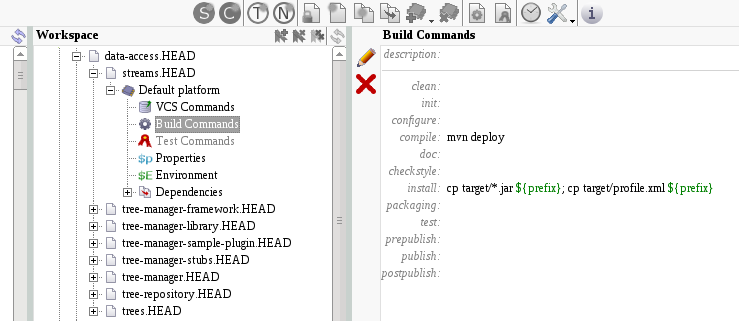Difference between revisions of "Creating gCube Maven components: How-To"
(→Creating the ETICS Configurations) |
(→Environment) |
||
| Line 25: | Line 25: | ||
== Environment == | == Environment == | ||
| − | Unlike Ant-based components, Maven components do not use the <code>CLASSPATH</code> variable for compile-time dependency resolution, but rely on the Maven local repository. This means that the | + | Unlike Ant-based components, Maven components do not use the <code>CLASSPATH</code> variable for compile-time dependency resolution, but rely on the Maven local repository. This means that the Environment section of Maven component's configurations '''will be empty''' (unless other environment variables has to be set for other purposes). |
There exist an exception, though. If the component's artifact is meant to be used as compile-time dependency by others Ant-based components, the artifact produced by the Maven build needs to be ''exported'' in the CLASSPATH to allows the Ant-based component to find it. Only in this case the Environment section will contain an entry like: | There exist an exception, though. If the component's artifact is meant to be used as compile-time dependency by others Ant-based components, the artifact produced by the Maven build needs to be ''exported'' in the CLASSPATH to allows the Ant-based component to find it. Only in this case the Environment section will contain an entry like: | ||
Revision as of 11:47, 3 May 2012
Contents
Developing a gCube Maven Component
Creating the ETICS Configurations
This sections is meant to provide operative instructions
Build Commands
- the compile target of their Build Commands must invoke Maven to build the components up to the deploy phase (e.g.
mvn deploy). This allows the deployment of components into Maven repositories directly from ETICS builds
- the install target of their Build Commands must copy the gCube profile of the component in the
${prefix}directory. This allows the registration of the profile with the Software Gateway when the component is released. It remains a good practice to copy also the outcome of the compilation (usually jar files) in${prefix}in order to include them in packages generated by ETICS
Sample build commands for a maven-based component should look like the one in the picture below:
Dependencies
The configuration must directly or indirectly depend on the ETICS configurations of all gCube components that are specified in the POM, including maven-parent.
Dependencies on third-party components available in Maven Central (or other Maven repository specified in the POM) do not need to be configured in ETICS (i.e. Maven repositories replace ETICS externals).
Environment
Unlike Ant-based components, Maven components do not use the CLASSPATH variable for compile-time dependency resolution, but rely on the Maven local repository. This means that the Environment section of Maven component's configurations will be empty (unless other environment variables has to be set for other purposes).
There exist an exception, though. If the component's artifact is meant to be used as compile-time dependency by others Ant-based components, the artifact produced by the Maven build needs to be exported in the CLASSPATH to allows the Ant-based component to find it. Only in this case the Environment section will contain an entry like:
CLASSPATH: ${moduleDir}/target/artifactFilename.jar
